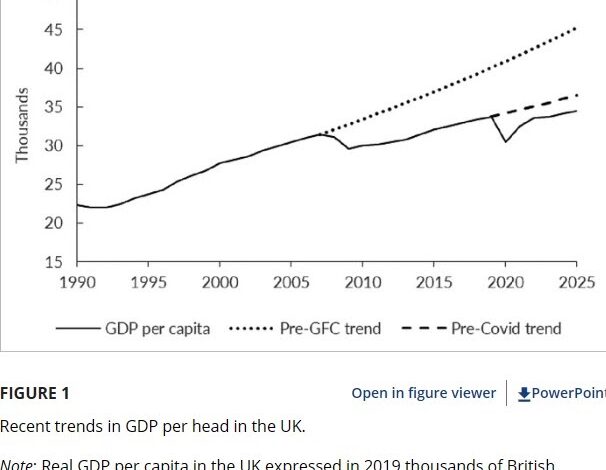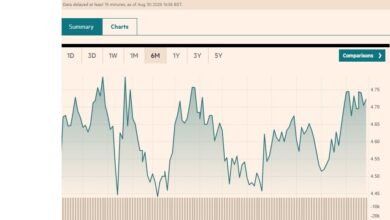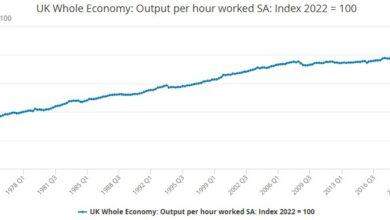
.
Jagjit
Chadha (ex head of NIESR and now a Professor at Cambridge) and
Issam
Samiri have an article
in the Journal of Economic Surveys that focuses on the
UK’s recent productivity problem. The chart above is taken from
that article. Economic growth (or not), and therefore how fast living
standards rise (or don’t) is all about productivity growth over the
medium and long term. The UK’s problem is this. Productivity growth
slowed in all the advanced economies from around 2005 onwards, but it
declined by more in the UK, and that relative decline has continued
until today.
There is not much the UK can do to buck international trends in
productivity. There was no way UK GDP per head was going to continue
to grow at pre-2005 rates, so the chart above greatly exaggerates the
problem. The survey discusses potential reasons why global
productivity growth started slowing around 2005. One story is that
the earlier boost to productivity provided by IT in the 1990s started
to fizzle out, but to be honest we have more stories than clear
answers on this. However, between around 1980 and 2005 the UK kept
pace with the US, Germany and France on productivity growth, so there
was no UK productivity problem over that period. Those who say the UK
has always been in relative decline are just factually wrong.
So what caused the relative UK decline in productivity from around
2005 onwards? The paper goes through various different studies and
explanations, and I cannot repeat them all here. How much is due to
the importance of banking to the UK economy, so the Global Financial
Crisis had an outsize impact on UK productivity growth? Did slower
global growth have more of an impact on the UK than elsewhere? Coyle
and Mei in a 2023 paper in Economica found that the UK productivity
slowdown was largely driven by the manufacturing and information and
communication sectors.
Below, in another chart taken from the paper, is the UK’s
investment to GDP share relative to other major economies. Investment
doesn’t just provide capital that helps produce output, but it is
often how technical advances are embodied in production. [1]
.
In the
1960s UK investment was substantially lower than in the US, Germany
or France, but by the 1970s the UK was at least within touching
distance of these other countries. It may reasonably take some time
for higher investment rates to show up as higher productivity growth,
so perhaps the UK’s relatively good productivity performance
from around 1980 was the delayed response to this higher level of
investment. Equally, perhaps the decline in relative productivity
from around 2005 was due to the decline in the UK investment share
compared to these other countries from around 1995.
One idea I looked at in
a previous post was that austerity, by delaying the
UK’s economic recovery from the Global Financial Crisis, may have
had a permanent negative impact on productivity through lower
investment. I concluded that austerity, in creating an unusually
protracted recovery in aggregate demand from the GFC recession, did
have some negative impact on productivity growth and therefore a
persistent negative impact on output supply, but how large that
effect may have been is very difficult to quantify.
As the chart at the top of the page shows, we actually have two UK
productivity/growth problems: the one discussed above, and another
that is more recent. In the UK the pandemic appears to have been assciated with a
fall in productivity, and perhaps a subsequent growth rate that is
even slower than since the mid 2010s. Luckily that is easier to
explain, as we can see from the chart above. Whereas the investment
share in Germany, France and the US went on increasing through the
2010s, the UK share started declining around 2016. The reason is of
course Brexit, and lower investment isn’t the only reason that
Brexit would lead to lower productivity growth.
While Brexit was clearly an act of national self harm in terms of
productivity growth and therefore UK living standards, the reasons
for the UK’s relative decline in productivity growth from the
mid-2000s remains something of a mystery, with many potential stories
with little consensus about which if any are the more important. My
own instinct is that the UK’s low levels of investment compared to
other countries since the mid-1990s has to be a key part of any
explanation of relatively low productivity growth, but the reasons
for these low levels of investment in the UK also remain largely unexplained.
[1] The structural econometric macromodel I and others created
in the 1990s had a vintage production function, where technical
progress is embodied in new investment.
Source link






